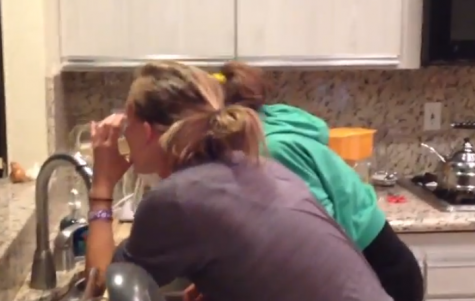The Cinnamon Challenge is KILLING OUR KIDS
Or maybe it isn’t. Who the hell knows?
Sometime around last September there was a media query looking for parents whose teens had tried the cinnamon challenge. I responded that my kid had and a producer from the Dr. Oz show wanted to know if she had any bad experiences from it? I stated that she hadn’t and asked why they were looking for teens and the reply was: BECAUSE KIDS ARE DYING.
Well, no. They actually aren’t but that was a nice try.
Is the cinnamon challenge good for you? Probably not. Is it smart? Nothing that makes a mess on my kitchen counter is smart. Is every news outlet in America going to spend the week getting shrill with Oh My Gawd Collapsed Lung!? Yes. That will happen. We love to save the children, social media is bad for the children, memes are bad for the children, ingesting spices is bad for the children and while you’re at it stop saying The F Word so much the children have delicate ears.
This new breed of hysteria is obscene.
According to the American Academy of Pediatrics (the same folks who want your toddler to have zero screen time and think that you should engage your 0-2 year old every second of the day):
Videos of people attempting the Cinnamon Challenge have become an Internet sensation. Typically, a video reveals a group of adolescents watching as someone taking the challenge begins coughing and choking when the spice triggers a severe gag reflex in response to a caustic sensation in the mouth and throat. As of August 10, 2012, there were 51 100 YouTube clips depicting the Cinnamon Challenge. One video was viewed 19 million times, predominantly by 13- to 24- year-olds, ages similar to people taking the Cinnamon Challenge and associated with the greatest need for conformity. These videos have raised concerns of choking, aspiration, and pulmonary damage. In most cases, the effects are temporary, yet the Cinnamon Challenge has led to dozens of calls to poison centers, emergency department visits, and even hospitalizations for adolescents requiring ventilator support for collapsed lungs.
These “hospitalizations” are referenced in a footnote that links to this video which is hosted on the Akron Children’s Hospital website. Below the video it reads: Related to Conditions: Asthma
If you don’t feel like watching a local news channel (can’t really blame you) I’ll give you the highlights. People post the cinnamon challenge online, it’s funny, people do it at home, more than 100 people called poison control, 30 people sought medical attention one collapsed lung in an asthmatic child.
From the American Association of Pediatrics:
The temporary responses to cinnamon are common to several substances and probably do not increase the risk of long-term damage.
Thus, the Cinnamon Challenge may pose greater and unnecessary health risks for persons allergic to cinnamon or with bronchopulmonary diseases, including asthma.
I assure you that the three researchers who published this very preliminary study were careful in choosing their words. I was going to throw in some interesting statistics about how many kids break their arms on school yards or lose limbs crossing the street but then I remembered that some of y’all might completely lose it and wrap your precious kids in bubble wrap after hearing those numbers.
To be perfectly clear 100+ phone calls to poison control doesn’t matter and it’s important that smart people understand why it’s a meaningless number. What happens is that people call Poison Control and say that their child has done the cinnamon challenge and that they coughed. Then Poison Control tells them that their child will be fine. They hang up the phone and shortly thereafter the child is fine. That 100+ people called Poison Control only matters if there is actual poison involved.
If you read the whole study you’ll get this paragraph:
According to the Florida Poison Information Center–Miami, between July 2011 and June 2012, there were 26 calls regarding cinnamon exposure in individuals ranging from age 1.5 to 83 years. Most patients had only minor consequences that resolved after dilution, irrigation, and washing the affected area, and most did not require follow-up. Of the 5 cases that did involve follow-up, symptoms resolved in 1 to 2.5 hours. Of the overall 26 cases, 13 (all youths aged 8–18 years) involved the Cinnamon Challenge. Of these 13 cases, 2 had “potentially toxic” exposures. Common symptoms included coughing and burning of the mouth, nose, and throat. More serious symptoms included extensive coughing, vomiting, nosebleed, and chest tightness. With only 1 exception (emesis), possible aspiration and pulmonary symptoms were limited to adolescents, all of whom had ingested dry powder from the Cinnamon Challenge. Although the known health risks of the challenge are relatively low, they are unnecessary and avoidable.
Now I understand that if you’re a researcher your job is to recommend that children avoid anything painful or irritating but by their own words the health risks are low. I’d say they’re infinitesimal. We have one meaningful injury where an asthmatic child was injured and there are 763,000 results for cinnamon challenge on YouTube.
The moral of the story is that if your child has asthma the only thing that they should breathe in is air. Everyone else might have a sore throat or watery eyes, it’s dumb, but we have to let kids be a little dumb. If you tell your kid that the cinnamon challenge is going to kill them and 763 million videos show them that you’re wrong they will never believe you when you tell them about the things that really are dangerous. And I wouldn’t believe you either.
Do we really need the every major news outlet to pick up on this as a dramatic story?
Push back. Tell the media that you aren’t buying the mindless fear they’re selling.
And none of this would be complete without showing you my daughter’s cinnamon challenge video which is so 2012….
